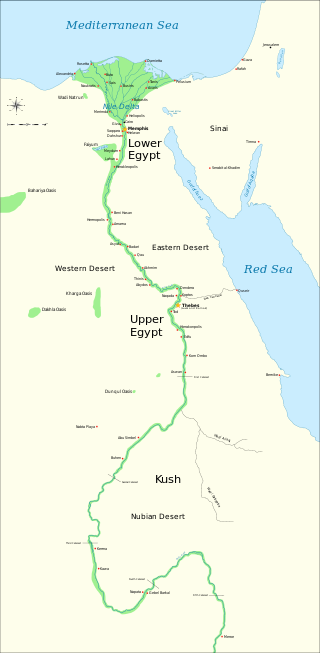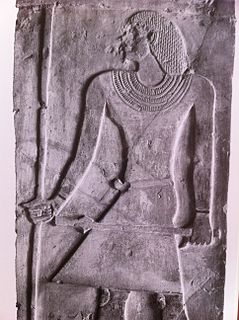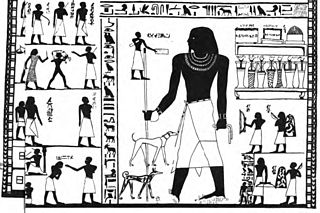
The First Intermediate Period, described as a 'dark period' in ancient Egyptian history, spanned approximately 125 years, c. 2181–2055 BC, after the end of the Old Kingdom. It comprises the Seventh, Eighth, Ninth, Tenth, and part of the Eleventh Dynasties. The concept of a "First Intermediate Period" was coined in 1926 by Egyptologists Georg Steindorff and Henri Frankfort.

Sehertawy Intef I was a local nomarch at Thebes during the early First Intermediate Period and the first member of the 11th Dynasty to lay claim to a Horus name. Intef reigned from 4 to 16 years c. 2120 BC or c. 2070 BC during which time he probably waged war with his northern neighbor, the Coptite nomarch Tjauti. Intef was buried in a saff tomb at El-Tarif, known today as Saff el-Dawaba.

Amenemhat IV was the seventh and penultimate king of the Twelfth Dynasty of Egypt during the late Middle Kingdom period, ruling for more than nine years in the late nineteenth century BC or the early eighteenth century BC.

Hedjkheperre Setepenre Smendes was the founder of the Twenty-first Dynasty of Egypt and succeeded to the throne after burying Ramesses XI in Lower Egypt – territory which he controlled. His Egyptian nomen or birth name was actually Nesbanebdjed meaning "He of the Ram, Lord of Mendes", but it was translated into Greek as Smendes by later classical writers such as Josephus and Sextus Africanus. According to the Story of Wenamun from c. 1000 BC, Smendes was a governor of Lower Egypt during the Era of the Renaissance under the reign of Ramesses XI, however, Egyptologists have questioned the historical accuracy of that story.

Khasekhemre Neferhotep I was an Egyptian pharaoh of the mid Thirteenth Dynasty ruling in the second half of the 18th century BC during a time referred to as the late Middle Kingdom or early Second Intermediate Period, depending on the scholar. One of the best attested rulers of the 13th Dynasty, Neferhotep I reigned for 11 years.

Nubkheperre Intef was an Egyptian king of the Seventeenth Dynasty of Egypt at Thebes during the Second Intermediate Period, when Egypt was divided by rival dynasties including the Hyksos in Lower Egypt.
Thinis was the capital city of the first dynasties of ancient Egypt. Thinis remains undiscovered but is well attested by ancient writers, including the classical historian Manetho, who cites it as the centre of the Thinite Confederacy, a tribal confederation whose leader, Menes, united Egypt and was its first pharaoh. Thinis began a steep decline in importance from Dynasty III, when the capital was relocated to Memphis, which was thought to be the first true and stable capital after the unification of old Egypt by Menes. Thinis's location on the border of the competing Heracleopolitan and Theban dynasties of the First Intermediate Period and its proximity to certain oases of possible military importance ensured Thinis some continued significance in the Old and New Kingdoms. This was a brief respite and Thinis eventually lost its position as a regional administrative centre by the Roman period.

Neferkauhor Khuwihapi was an ancient Egyptian pharaoh of the Eighth Dynasty during the early First Intermediate Period, at a time when Egypt was possibly divided between several polities. Neferkauhor was the sixteenth and penultimate king of the Eighth Dynasty and as such would have ruled over the Memphite region. Neferkauhor reigned for little over 2 years and is one of the best attested kings of this period with eight of his decrees surviving in fragmentary condition to this day.

Ankhtifi was a nomarch of Hierakonpolis and a supporter of the pharaoh in Herakleopolis Magna, which was locked in a conflict with the Theban based 11th Dynasty kingdom for control of Egypt. Hence, Ankhtifi was possibly a rival to the Theban rulers Mentuhotep I and Intef I. He lived during the First Intermediate Period, after the Egyptian Old Kingdom state had collapsed, and at a time when economic hardship, political instability, and foreign invasion challenged the fabric of Egyptian society.
This page list topics related to ancient Egypt.

Intef, whose name is commonly accompanied by epithets such as the Elder, the Great or born of Iku, was a Theban nomarch during the First Intermediate Period c. 2150 BC and later considered a founding figure of the 11th Dynasty, which eventually reunified Egypt.

Shemay was an ancient Egyptian official and later vizier toward the end of the 8th Dynasty during the First Intermediate Period, mainly known for being the beneficiary of most of the Coptos Decrees. His career has been interpreted as a glaring sign of the extreme weakness of the central power, forced to bestow great privileges to maintain the loyalty of powerful local governors. Shemay is buried in a mudbrick mastaba just south of Coptos.

Amenemhat, often reported with his short form Ameny (Jmnjj), was an ancient Egyptian "Overlord of the Oryx nome" and chief priest during the reign of pharaoh Senusret I of the 12th Dynasty.

The Oryx nome was one of the 42 nomoi in ancient Egypt. The oryx nome was the 16th nome of Upper Egypt, and was named after the Scimitar oryx. It was located, approximately, in the territories surrounding the modern city of Minya in Middle Egypt.
Iushenshen was an ancient Egyptian town in the Coptic nome in Upper Egypt. It is a few times mentioned in Ancient Egyptian sources. According to the Ramesside Onomastica the place was located south of Coptos. 25 km (16 mi) south of Coptos there is the modern town called Khozam where ancient monuments have been found, and it seems possible that Khozam was ancient Iushenshen. Near Khozam were excavated several cemeteries with some of them dating back to the Badarian Period. Near Khozam the false door of the local governor User and the false door of the overseer of Upper Egypt Tjauti were also found, they date to the very end of the Old Kingdom. These high officials were evidently buried here and it seems that the capital of the Coptite nome moved at the end of the Old Kingdom to this place. Iushenshen was destroyed in the First Intermediate Period. A stela of a certain Khenmes reports that he was sent to the town and rebuilt it.

Idy was an important Ancient Egyptian official in the Eighth Dynasty known from several sources. He lived at the beginning of the First Intermediate Period and was the son of Shemay, who is also known from several monuments and decrees from Koptos. His mother was the king's daughter Nebet. Idy appears on many royal decrees found at Koptos. There he bears the important title of a vizier, but was also overseer of Upper Egypt and overseer of priest and count. The decrees are dated under king Neferkauhor and Neferirkare. One decree is addressed to Shemay and dates under Neferkauhor. It reports the appointment of Idy to the overseer of Upper Egypt. A second one mentions affairs in the temple of Min at Koptos. In a third decree Idy bears the titles of a vizier. In the decree, the king protects the statues and the funerary cult of Idy. The decree is dated under king Neferirkare, who was the successor of Neferkauhor. It seems that Idy took over many positions that his father hold before.
Sobeknakht I was an ancient Egyptian official of the Second Intermediate Period. He was local governor at Elkab.

Hetepi was an ancient Egyptian official of the First Intermediate Period, around 2200 BC. He is known from his stela that is now in the National Archaeological Museum of Florence. The stela was bought in 1884–1885 by Ernesto Schiaparelli. The original provenance was not known, but must come originally from Naqada, where there was a cemetery of the First Intermediate Period. Hetepi was sole friend and inspector of priests. From other sources it is known that these local inspectors of priests also had non-religious functions and were therefore the local governors of their towns. Henry George Fischer showed that the cemeteries near Naqada were those of Qus on the other side of the Nile. Hetepi was therefore governor of Qus. On the stela is also shown his son Dagi, who bears the same titles and who was most likely the successor in office.

Khety was an ancient Egyptian local governor of the Oryx nome in Middle Egypt in the Twelfth Dynasty. He is only known from his decorated tomb chapel at Beni Hasan. In the decoration of his tomb chapel appear several inscriptions providing the name and titles of Khety. He was great overlord of the entire Oryx nome. This is the main title of the local governors of the Oryx nome. Other titles include count (Haty-a), royal sealer, sole friend, king's acquaintance, who is in the chamber, who belongs to Nekhen and overlord of Nekheb, but also overseer of troops at all secret places. Not much is known about his family. His father was a person called Baqet, his wife was called Khnumhotep and there is one son attested with the name Khety. Naguib Kanawati wonders whether Khety was the son of Baqet III. The latter's tomb and those of Khety share the same plan and are close to each other.

Meni, Meny or Menankhpepy was an ancient Egyptian high official who lived during the reigns of Pepy I and Merenre Nemtyemsaf I, in the late Sixth Dynasty. Most of what is known about his life comes from his mastaba burial tomb in the Dendera Necropolis, a few hundred metres south of the Temple to Hathor. This tomb was explored during 1897 and 1898 by a team led by the British archaeologist Flinders Petrie.















